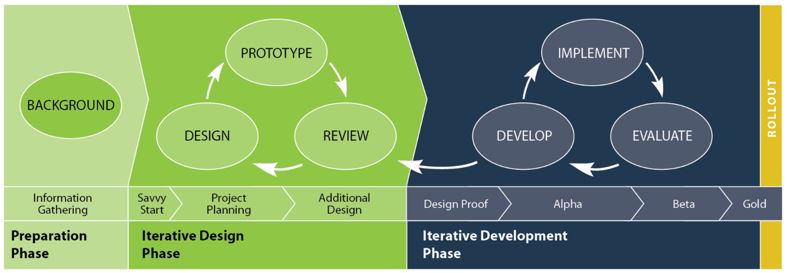
Image from YouTube.
While it has become a controversial subject in recent years, the concept of learning styles—the idea that we learn better when the instruction we receive is tailored to our preferred way of learning—still plays an important role when designing online curriculum.
Understanding how different people learn is important when design and delivering online training. You want your employees to not only retain the information you have prepared in your online course materials, but also be motivated to put the new knowledge and ideas into practice in the workplace.
As well, adult learners have unique needs that should be taken into consideration when developing curriculum. First, let’s get started by taking a look at the concept of learning styles.
Get your training online quickly with Udutu’s LMS
What Are Learning Styles?
There are various approaches to describing how people learn, and most of the concepts between the approaches overlap in some way. In a nutshell, learning styles are based on the concept that everyone learns differently and that curriculum should be presented in a variety of ways to facilitate individual learning styles.
Some researchers, as a very basic way to explain the concept, use the acronym “VAK“:
- Visual: some learners are visual, relying on reading, watching videos or diagrams, etc., to learn
- Auditory: some learners are auditory, and must listen to learn
- Kinesthetic: some learners “learn by doing”, and require movement to be incorporated into their learning
This concept of learning styles echoes Gardner’s theory of multiple intelligences. While his theories have become controversial over the past twenty years, Howard Gardner, a developmental psychologist, hypothesized that human intelligence is actually a combination of different “modalities” or intelligences:
Visual-Spatial
These learners think in terms of physical space, and are very aware of their environments. They like to draw, do jigsaw puzzles and read maps, and can be taught through drawings, and through verbal and physical imagery. Tools include models, graphics, charts, photographs, drawings, 3-D modeling, video, videoconferencing, television, multimedia, and texts with pictures, charts and graphs.
Bodily-kinesthetic
These learners communicate through body language and can be taught through physical activity, hands-on learning, acting out role playing. Learning and teaching tools include equipment and real objects.
Musical
These learners show sensitivity to rhythm and sound. They love music, but they are also sensitive to sounds in their environments. They may study better with music in the background. Teaching tools include musical instruments, music, radio, stereo, and multimedia.
Interpersonal
These learners thrive by understanding and interacting with others, and learn through interaction. Tools include the telephone, audio conferencing, time and attention from the instructor, video conferencing, writing, computer conferencing and E-mail.
Intrapersonal
These learners understanding their own interests and goals, and tend to shy away from others. They can be taught through independent study and introspection. Teaching tools include books, creative materials, privacy and time alone with the course materials.
Linguistic
These learners thrive by using words effectively. They often think in words and like reading, playing word games, and writing. Tools for teaching this style of learner include computers, games, videos, books, audio materials, and lectures.
Logical-Mathematical
These types of learners value reasoning and analysis, and think conceptually and in the abstract. They can be taught through logic games, investigations, mysteries. According to Gardener, they need to learn and form concepts before they can deal with details.
Caveats About Multiple Intelligences and Learning Styles
Gardener stressed that no one learner possesses a single intelligence, like the ones we outlined above. Instead, we all possess all of these multiple intelligences to varying degrees, influencing our own individual learning styles
Still, the concept of learning styles has received a large amount of skepticism in recent years.
“We have not found evidence from a randomized control trial supporting any of these,” says Doug Rohrer, psychologist at the University of South Florida, after examining studies of learning styles more closely.
However, research shows how learning is improved for most people by combining different activities – such as drawing alongside more passive study.
In practical terms, using an online learning approach that includes videos, reading, audio, exercises, social forums, and the like is a great way to hit on multiple learning styles. If you create learning for a living as an instructional designer or teacher, then blending your learning approaches is an effective way to make your learning stick.
Adult Learners Have Unique Needs
Above and beyond multiple intelligences and learning styles, it’s also important when designing curriculum that adults have unique needs in the classroom.
According to Malcolm Knowles, a pioneer in the field of adult learning, there are 6 main characteristics of adult learners:
Adult learning should be relevant
The motivation for adults to learn increases when the curriculum appears to be relevant to real-life situations is clear.
Adult learning should be goal-oriented
Learning activities should directly contribute to achieving students’ personal learning objectives, such as completing a certification that allows them to accomplish a professional goal.
Adult should be practical
Learning is happens when the curriculum makes it clear how theoretical knowledge can be applied to real-life situations to solve a problem.
Adult learning encourages collaboration
Adult learners thrive in collaborative relationships with their instructors. When learners are considered by their instructors as colleagues and peers, they become more productive.
Adult learning is self-directed
Students need to be given the freedom to assume responsibility for their own choices. When it comes to workload, they also need to be proactive in making decisions and in contributing to the process.
Adult learning utilizes knowledge and life experiences
Learners should be encouraged to bring to their current placement past knowledge, opinions, and experiences.
What Does This All Mean For Your Online Curriculum Development?
Do to the sheer combination of different learning styles, intelligences and the needs of adult learners, it may seem like there is an infinite number of factors to consider when designing your online curriculum.
Instead, to keep things simple, remember that adults tend to value practicality and relevance when learning. It’s also important to create different activities and tasks that accommodate different learning styles.
Even if there is some debate about whether or not learning styles actually exist, there is little argument that learners respond the best to variety when learning, as well as relevant coursework activities.
If you’re interested in diving deeper into this subject, be sure to read 3 Tips for Engaging Course Design and Evaluating Training and eLearning.






